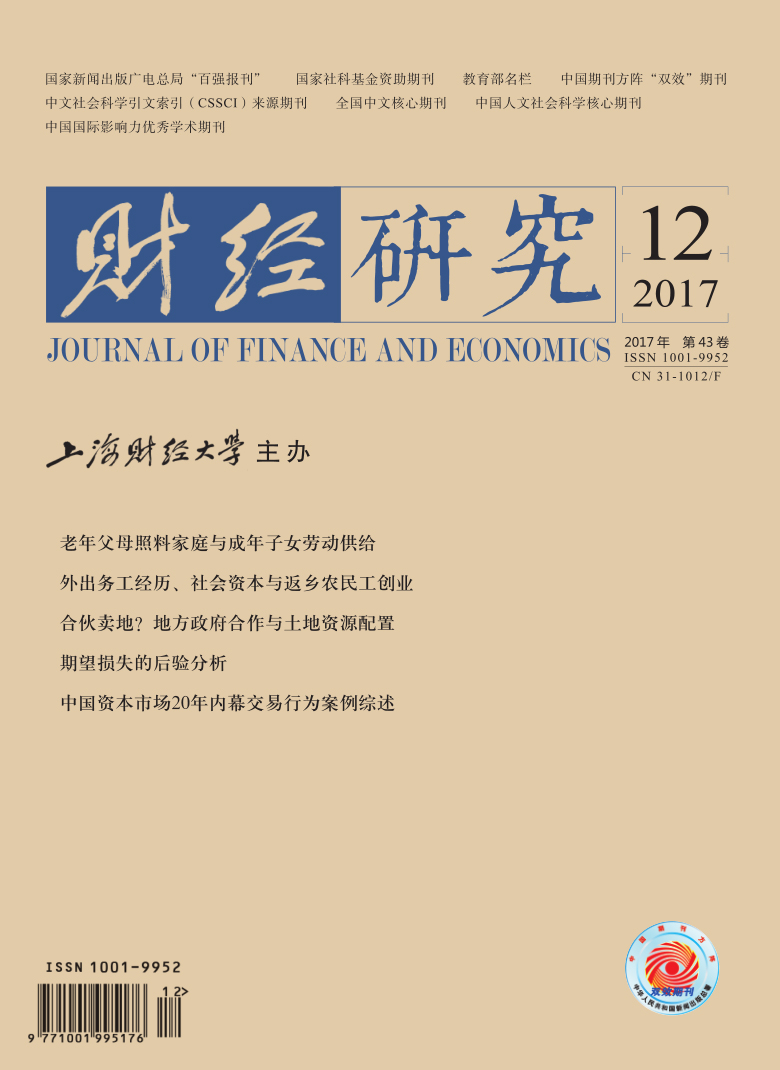[1]Chen Y, Xing C. Rural modernization and the role of education in rural labor market[J]. Economic Research Journal, 2004, (8): 105-116. (In Chinese)
[2]Deng Q. Earnings differential between urban residents and rural migrants: Evidence from Oaxaca-Blinder and quantile regression decompositions[J]. Chinese Journal of Population Science, 2007, (2): 8-16. (In Chinese)
[3]Ge Y. Sectoral choice and the gender wage gap: 1988-2001[J]. China Economic Quarterly, 2007, 6(2): 607-628. (In Chinese)
[4]Huang F, Sun S. Market allocation of rural land resources: Labor transfer and market development of farmland use rights[J]. Management World, 2015, (7): 71-81. (In Chinese)
[5]Ji Y, Liu Y, Chen Y, et al. Part-time jobs and pesticide input: A perspective of collective prevention[J]. Journal of Nanjing Agricultural University (Social Sciences Edition), 2015, (6): 61-67. (In Chinese)
[6]Ju X. A study on the effect of part time farming of farm households to peasants’ income in Shandong province[D]. Qingdao: Ocean University of China Thesis for Master Degree, 2012. (In Chinese)
[7]Yue J, Ye H. Is the value of religion or the demand for tools for farmers to believe in religion: Evidence from CHIPS data[J]. Management World, 2012, (11): 67-76. (In Chinese)
[8]Li R, Du Z, He Q. Rich dad, poor dad and offspring income inequality[J]. China Economic Quarterly, 2014, (1): 213-258. (In Chinese)
[9]Liao H. Farmers’ concurrent business and its influence on land right transfer in Chinese rural[J]. Management World, 2012, (5): 62-70. (In Chinese)
[10]Luo Y, Fan L. Spatial characteristics of rural infrastructure income increasing effect in China: Based on spatial correlation and spatial heterogeneity[J]. Management World, 2012, (5): 71-87. (In Chinese)
[11]Qian Z. Does non-agricultural employment lead to rural land transfer: A theoretical analysis of family internal labor division and its impact on Chinese farmers’ concurrent occupation[J]. Chinese Rural Economy, 2008, (10): 13-21. (In Chinese)
[12]Wang D, Cai F, Zhang G. Employment and wage determination of rural migrant workers: The role of education and training[J]. China Economic Quarterly, 2008, (4): 1131-1148. (In Chinese)
[13]Wei Z. The role of health on off-farm employment and wage decision[J]. Economic Research Journal, 2004, (2): 64-74. (In Chinese)
[14]Xia Y. The effect of land system transformation, concurrent business on peasants’ incomes: Comparison between Japan and China[D]. Shenyang: Liaoning University Thesis for Master Degree, 2012. (In Chinese)
[15]Xie S, Yao X. Quantitative analysis of wage discrimination of migrant workers[J]. Chinese Rural Economy, 2006, (4): 49-55. (In Chinese)
[16]Xu Q, Zhao S, Liu J. Labor loss, capital-labor Substitution and agricultural production[J]. Working paper, 2017. (In Chinese)
[17]Ye J, Zhou Y. Social capital and migrant workers’ income: Evidence from migrant workers in Beijing[J]. Management World, 2010, (10): 34-46. (In Chinese)
[18]Yin Z, Gan L. Wage differentials between public and nonpublic sector in China[J]. Economic Research Journal, 2009, (4): 129-140. (In Chinese)
[19]Zhang H. The problem of farmer’s income under the new normal economic situation[J]. Issues in Agricultural Economy, 2015, (5): 4-11. (In Chinese)
[20]Zhang Z, Qian W. Study on farmers’ willingness of land transfer under different levels of concurrent business: Based on the investigation and evidence in Zhejiang province[J]. Issues in Agricultural Economy, 2014, (3): 19-24. (In Chinese)
[21]Zhao J, Kong X, Sun D, et al. Production efficiency appraisal to China’s agriculture on part-time job[J]. Chinese Rural Economy, 2013, (3): 16-26. (In Chinese)
[22]Zheng X, Xu Z. Endowment restriction, factor substitution and induced technological innovation: A case research on the grain producing mechanization in China[J]. China Economic Quarterly, 2016, (1): 45-66. (In Chinese)
[23]Zhong N. Can rural industrialization keep working in China[J]. Economic Research Journal, 2011, (1): 18-27. (In Chinese)
[24]Blinder A S. Wage discrimination: Reduced form and structural estimates[J]. Journal of Human Resources, 1973, 8(4): 436-455.
[25]Heckman J J. Sample selection bias as a specification error[J]. Econometrica: Journal of the Econometric Society, 1979, 47(1): 153-161.
[26]Kilic T, Carletto C, Miluka J, et al. Rural nonfarm income and its impact on agriculture: Evidence from Albania[J]. Agricultural Economics, 2009, 40(2): 139-160.
[27]Machado J A F, Mata J. Counterfactual decomposition of changes in wage distributions using quantile regression[J]. Journal of Applied Econometrics, 2005, 20(4): 445-465.
[28]Maddala G. Limited dependent and qualitative variables in econometrics[M]. Cambridge: Cambridge University Press, 1983.
[29]Neuman S, Oaxaca R L. Gender versus ethnic wage differentials among professionals: Evidence from Israel[J]. Annales d'Economie et de Statistique, 2003, (71/72): 267-292.
[30]Neumark D. Employers’ discriminatory behavior and the estimation of wage discrimination[J]. Journal of Human Resources, 1988, 23(3): 279-295.
[31]Nguyen L D, Raabe K, Grote U. Rural-urban migration, household vulnerability, and welfare in Vietnam[J]. World Development, 2015, 71: 79-93.
[32]Yao Y. The development of the land lease market in rural China[J]. Land Economics, 2000, 76(2): 252-266.





 7481
7481  5540
5540

